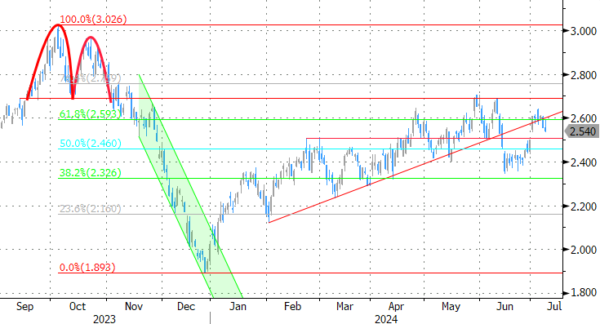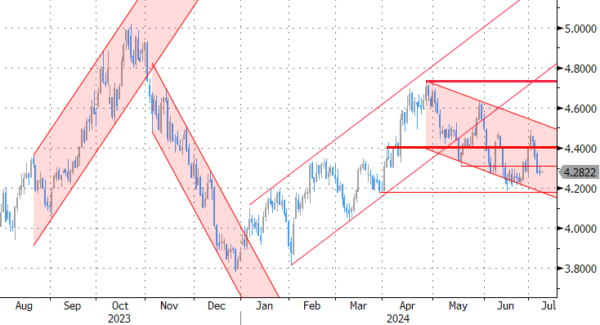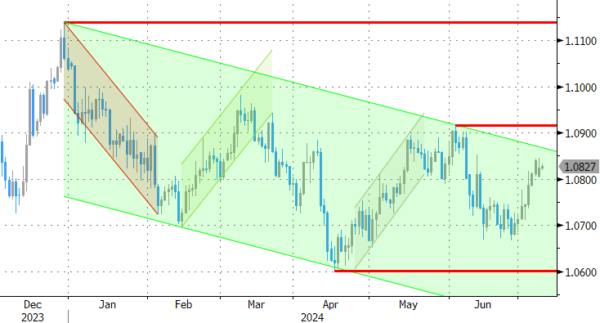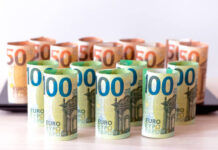Markets
A surprise but inconclusive outcome of the French parliamentary election after some initial jitters also resulted in an inconclusive market (European) reaction yesterday. As the left group Nouveau Front Populair gained most seats in Parliament (180) they might try to take the initiative, but reaching the support of a 289-majority to execute their own (or a compromise) program with support of other center groups is far from evident. The French 10-y spread (vs Germany) yesterday eased 3 bps (66 bps), but stays well above the levels recorded before the European elections (< 50 bps). Even as an outright tax-and-spend scenario can be avoided due to the political stalemate, it is unlikely for the political risk premium of France (but also of other EMU countries) to again reverse anytime soon. The ‘relief’ after the outcome of the election early in the session triggered a limited underperformance of Bunds, but the rise in yields was undone later in US dealings as US yields maintained a tentative downward bias after Friday’s softer than expected payrolls. German yields in the end changed between +1.7 bps (2-y) and -2.0 bps (30-y). US yields showed a very similar picture (2-y +2.5 bps, 30-y minus 1.2 bps). EUR/USD whipsawed intraday. In the end the pair at 1.0824 still closed marginally lower compared to Friday’s close. The EuroStoxx50 ceded 0.2%. The S&P 500 (+0.1%) and the Nasdaq (+0.28%) still closed at record levels.
Asian equities mostly traded in positive territory with Japan outperforming (Nikkei 225 +2.35% at new record high). US Treasuries and the dollar trade little changed as investors are counting down to Fed Chair Powell’s testimony before the Senate Banking Committee. Aside from Powell’s testimony, the US NFIB small business confidence is the only data release worth mentioning. The Fed Chair probably will applaud the slowing in the monthly price rise in May. Friday’s (mildly) softer than expected payrolls (including unemployment uptick to 4.1%) also might cause the Fed Chair to reconfirm that its policy is guided by the double mandate of price stability and at same time maximal employment. We expect the Fed Chair to hold a mildly dovish tone, but still looking for further confirmation that inflation is cooling further with Thursday’s US June CPI the next high profile data reference. We expect US yields to maintain a cautious downside bias. Two Fed rate cuts by December are fully discounted. Some more anticipation on faster Fed easing has to become visible in the 2025 (+) sector of the curve. The US 2-y yield post payrolls dropped below the 4.70/65% support area, with 4.55% (end March low) next reference on the technical charts. In a steepening move, the US 10-y yield (currently 4.28%) still as some room ahead of the 4.19% mid-June correction low. The combination of a soft tone of Fed Chair Powell and European risk moving a bit to the background might help EUR/USD to move closer to the 1.0916 early June ST range top.
News & Views
The British Retail Consortium said that total sales in June fell by 0.2% y/y after the 0.7% uptick in May. It’s only the second negative reading in almost two years (the other one being a sharp –4% y/y in April). Surveying the same stores, showed retail sales dropping 0.5% y/y. The decline was concentrated in the non-food department, whose three-month moving average was negative (-2.9%) for 11 months straight now. Food still rose a 1.1%. BRC blamed the cold spell in June for the poor reading with consumers reining in spending on clothing particularly. An unusually wet month of April was also the culprit for the dire reading back then. BRC’s chief executive ended on a positive note though, saying that “Retailers remain hopeful that as the summer social season gets into full swing and the weather improves, sales will follow suit”.
The NY Fed June’s consumer inflation survey revealed their expectations declining at the short- and longer-term horizons while increasing slightly at the medium term. The one-year-ahead and five-year-ahead median gauges fell to 3.0% and 2.8% respectively. The three-year-ahead one increased to 2.9% (+0.1 ppt). Expectations about home price growth decreased to 3.0% from 3.3% and one-year-ahead expected earnings growth increased by 0.3 ppts point to a 3.0%. The latter is above than the 12-month moving average (2.8%) as well as the highest reading since September 2023. Expected growth in government debt one year from now remained unchanged at 9.3%.
Graphs
GE 10y yield
The ECB cut its key policy rates by 25 bps at the June policy meeting. A more bumpy inflation path in H2 2024, the EMU economy gradually regaining traction and the Fed’s higher for longer US strategy make follow-up moves difficult. Markets are coming to terms with that. Meanwhile, much of the save haven bids were reversed after the (first round in) the French elections. The 2.34%-2.4% support zone looks solid.
US 10y yield
The Fed needs more evidence than just one slower-than-expected (May) CPI provided. June dots suggest one move in 2024 and four next year. The long end of the curve was also supported by increased odds of a Trump presidency after the debate with Biden. At the same time, softer US labour market data are fuelling the debate on the September Fed rate cut, steepening the curve.
EUR/USD
EUR/USD is stuck in the 1.06-1.09 range. The desynchronized rate cut cycle with the ECB taking the lead and a swing to the right in European elections pulled the pair to the 1.0665 area. However, the dollar also lost some momentum as the Fed is turning its focus to a potential softening of the labour market, potentially opening the way for policy easing in September.
EUR/GBP
Debate at the BOE is focused at the timing of rate cuts. May headline inflation returned to 2%, but core measures weren’t in line with inflation sustainably returning to target any time soon. Still some BoE members at the June meeting appeared moving closer to a rate cut. This might cap further sterling gains. Labour has yet to reveal its policy plans after securing a landslide election victory. EUR/GBP 0.84 is solid support.

















